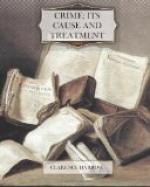Man sees an object. Instinctively he may fear it or he may hate it. He may run from it or destroy it. He gathers impressions through his senses. The nerves carry them to the brain. He comes to fear certain persons and things, to hate certain other persons or things, and to love still others. If the hatred is strong enough or the danger great enough or the desire sufficient, he may kill. Whether he plans the method or deliberates upon the act can make no difference. He is prompted by the instinct, and the reflection simply means the consideration of reasons for and against, or the reaching of inhibitions. If he acts, it is one of the primal emotions that causes the act. He is the “machine” through which certain emotions find their path and do their work. Infinite are the causes and circumstances that give rise to an emotion strong enough to take human life.
Killings which result from a sudden passion are easily understood. Everyone has been overwhelmed by rage, where reason and judgment and all acquired restraints are entirely submerged. The primitive man with his primitive emotion reasserts himself. It is mainly accident or the lack of some particular circumstance that prevents a murder. Of course some people are overwhelmed more easily than others. Some natures are less stable, some nervous systems less perfect, and the built up barriers are weaker. The whole result of stimuli is determined by the strength of the feeling acting upon the machine. Such a person is not ordinarily dangerous to the community. The act itself would generally assure that it could never happen again. Some killings, however, are more deliberate. They are preceded by a settled hatred which preys upon the mind and fights against the preventive influences that training and habit have formed. Under a certain combination of circumstances these restrictions are swept aside and the emotions have their way.
There are, of course, certain broad classifications of homicides. A considerable number, perhaps more than any other, come through the commission of robbery, burglary and larceny. In the midst of the act the offender is caught, and kills in an effort to escape. These murders fall under the heading of property crimes; the cause is the same, and the rules governing them are the same. The second group, with respect to numbers, grows from the relations of men and women. Wives kill husbands and husbands kill wives; sweethearts kill each other. Jealousy and revenge are commonly mixed with sex life and sex association. Many socialists have argued that under an equal distribution of property, where women were freed from fear of want, these crimes would disappear. But this argument does not take human nature into account. Jealousy is inevitably associated with sex relations. The close contact of men and women over long periods of time inevitably causes friction and misunderstanding. These conditions often grow chronic, and in marriage are aggravated by the necessity of close association regardless of the real feelings that may exist. Certain claims are made by husbands and by wives, which are probably inherent in the relationship; sometimes they flow from habit and custom, but, from whatever cause, such claims are so exacting that either the husband or wife finds them hard to meet.




